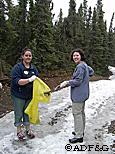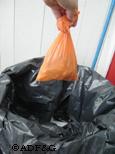Alaska Fish & Wildlife News
April 2007
Signs of Spring are Sometimes Unpleasant

You’re strolling along your favorite trail enjoying the budding signs of spring. The snow is melting, the birds are singing, and the air is filled with the scent of…melting dog poop?
Call it scat, feces or waste if you’d like. “Whatever you call it,” says Tracy Smith, “poop is a problem.” Smith is one of the Alaska Department of Fish and Game’s representatives on the Anchorage Scoop the Poop Committee.
Picking up after your dog doesn’t top anyone’s list of fun things to do. But are there things that stink worse (pun intended) than picking up dog poop? How about stepping in it? And after you’ve scraped it off your shoe, consider having to swim, fish, or drink water with dog poop in it.
Those little piles that stayed neatly frozen all winter are starting to warm up this spring. Contrary to popular belief, dog feces don’t just melt into the ground and become fertilizer. It actually takes a year to disintegrate completely, and the millions of fecal coliform bacteria that inhabit each pile of dog doo can stick around too. Rain washes the dog waste and bacteria into the nearest creek, lake, or storm drain. Water that goes through storm drains isn’t treated at the wastewater plant, which means that bacteria end up in the nearest waterway.
Thirteen water bodies in Anchorage are currently listed as polluted with fecal coliform. Those include such popular recreational sites as Campbell Creek, Campbell Lake, Chester Creek and Ship Creek. The contamination isn’t severe enough to endanger human health. At most, if you were unfortunate enough to swallow more than a few mouthfuls of water, you could probably expect an unpleasant digestive or intestinal episode. Still, salmon are caught from those waters and eaten, and thought of the “special sauce” they marinate in is enough to give anyone second thoughts about letting their dog squat wherever the fancy strikes them.
To be fair, no one can say that most of the fecal coliform bacteria contaminating our waterways comes from man’s best friend. But tens of thousands of dogs produce tons of waste every day.
“Fecal coliform bacteria come from warm-blooded animals,” explains Holly Kent of the Anchorage Waterways Council. “True, there is warm-blooded wildlife roaming in the Anchorage vicinity that could contribute fecal coliform to local waters. Before Anchorage was developed, the ecosystem was probably able to handle the waste of that wildlife. But now we’ve added a considerable number of additional contributors.”

What Kent and the Waterways Council found this past fall while working as coordinators of the Scoop the Poop Committee is that Anchorage has over 65,000 dogs – a high dog-to-person ratio. And as it turns out, Anchorage produces approximately 21,000 pounds of dog feces every day, which is about equivalent to seven adult male beluga whales. Individual yard owners pick up some of this waste but a significant amount is concentrated along trails, roads and public lands. That makes it likely that dog doo is a significant contributor to the fecal coliform issue in our waterways.
“It’s easy to see how with all those additional inputs the system could be overwhelmed,” says Kent.
The problem also likely affects any of Alaska’s populated urban centers where a concentration of people brings a concentration of dogs. Anchorage has addressed the problem in several ways. Each spring the municipality sponsors a clean up day where Anchorageites are encouraged to pick up some of the winter’s accumulation of dog waste. However, a one time effort was not enough and thus the Anchorage Scoop the Poop Committee was born.
The committee is a team effort of nonprofits, and federal and state agencies (including ADF&G) that together are striving to educate Anchorage dog owners about the benefits of exercising the doo-ties of responsible pet ownership.
In 2006, the Scoop the Poop Committee began a targeted education campaign armed with funding from Alaska Clean Water Actions (or ACWA). ACWA brings together the Department’s of Environmental Conservation, Natural Resources and Fish and Game to manage federal and state funding to address problems with Alaska’s water quality, water quantity and aquatic habitat. The idea is that with the ACWA funding, the Poop Committee can contribute to decreasing the fecal coliform pollution level in several of the affected Anchorage waterways by educating the public about the problem.
Will more Poop Committees spring up around the state? It’s hard to say. What can be said is that if folks figuratively tiptoe around the issue, they are sure to literally step right in it when they walk outside. This spring, be kind to your shoes and your local creeks: remember to pick up after your dog.
For more information of the Scoop the Poop Committee visit: www.anchoragecreeks.org and click on “Scoop the Poop”.
Stacie Hall is a fish biologist based in Anchorage.
Subscribe to be notified about new issues
Receive a monthly notice about new issues and articles.
